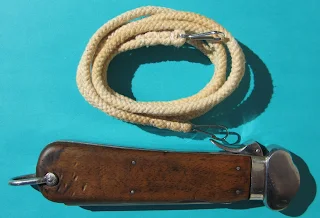When the formation of British Airborne Forces was initiated in 1940 there was little to no knowledge, let alone an experience base to draw upon for either training or equipment. The cadre of Army and RAF leadership given this daunting task
initially drew heavily from intelligence reports, and captured equipment of the
German Luftwaffe Fallschirmjäger. A fact I was not previously aware of was that 1,660
Although
not believed to be readily available to British Forces at the time a small book
(original copies now being exceptionally rare) was openly published in Germany in 1942. In this author's opinion its contents parallel some of the information which might have been available to British Army intelligence. The publicly published book was entitled, GANZE MÄNNER,
Leben und Erleben der deutschen Fallschirmjäger (Whole Men, Lives and
Experience of the German Paratroopers), authored by a Hauptmann Piehl (in all
probability the name or pseudonym of a serving Fallschirmjäger officer). My copy,
given its age is in excellent condition, but was published with wartime
materials, consequently the photographs are not as clear as they might be. However, they do exceed the quality of other copies of some of the same photographs seen elsewhere, and attributed to the Bundesarchiv. In
addition, due to the fragility of the document some of the scans are less than
perfectly square in orientation. For those who might be interested, an English
translation has been published, and is currently available at a very reasonable
price compared to an original. (http://www.alibris.com/booksearch?qwork=10287809&matches=9&cm_sp=works*listing*title).
Not having seen the reprint I cannot comment on the quality of its photographs.
What
follows are a series of photographs from the original book showing a variety of
the equipment and training techniques used by the Fallschirmjäger. Note the
similarity to those adapted by early British Airborne Forces. One major
exception, however, being the fundamental design difference between the German
standard RZ (1, 16, 20, 36) Series of parachutes, and the GQ/Irving Statichute or X-Chute. The latter being more comfortable in opening shock, ease of controlled descent, and landing. For those interested in a more detailed description of each of the parachute systems, please see the Links listing in this blog for two excellent sites.
Please double click on any of the images to enlarge them.
Please double click on any of the images to enlarge them.
One unique piece of equipment issued to the Fallschirmjäger (not shown in the book) was the Fliegerkappmesser (Flyer's Utility Knife), which while originally not specifically designed for paratroop use, was broadly issued, but very early became known as the Fallschirmjägermesser (as it is commonly named by collectors today). The Type I model was introduced into general issue in 1937. The knife was gravity activated, so could be operated with one hand, and incorporated a marlinespike. Two models were produced, the Type I which was of fixed construction, and a second Type II model capable of ready disassembly in order to facilitate replacement/repair of broken or defective parts. It so impressed British military authorities that a contract was tendered in 1943, to the renowned knife firm of George Ibberson & Co., Ltd. of Sheffield, to clone and produce 30,000 copies, but they were never issued on a broad scale, and are exceedingly rare. The knife shown below is a first model Fallschirmjägermesser, along with a reproduction of its issued lanyard, which appears to have been made of parachute shroud line. For those who might be interested, there is a definitive reference available on the knife; LUFTWAFFE GRAVITY KNIFE A History and Analysis of the Flyer's & Paratrooper's Utility Knife, M. Pattarozzi, Schiffer Publishing Ltd., Atglen, PA, 2006, ISBN: 0-7643-2419-5.
Another unique item of limited issue, which was specifically designed and built for the Fallsschirmjäger, was the Fallschirmjägergewehr 42 (FG42) automatic rifle. Its manufacture and initial issue obviously post-dates the publication of GANZE MÄNNER by approximately two years.
Its need was established based upon combat experience gained in the German airborne invasion of Crete in 1941(Operation 'Mercury'). The operation was anything else but mercuric in nature. In a precursor to the case of Operation Market Garden, the Luftwaffe intelligence staff seriously (some might even say gravely) underestimated British force strength on the island. As a result the casualties incurred by the Fallschirmjäger, both parachute and glider-borne troops, and Gibirgsjäger (mountain troops) which were air landed, were so severe that they were never committed to any subsequent significant parachute operations for the remainder of World War II, serving rather as elite infantry units.
In Crete the Fallschirmjäger found the broadly issued Erma 9mm Machinen Pistole MP38/40 (erroneously aka Schmeisser) to lack both range and accuracy. The development of the FG42 was initiated and the first model issued in 1943. First significant issue is believed to have been to the elite glider-borne Fallschirmjäger unit commanded by SS-Obersturmbannführer Otto Skorzeny, who rescued the Italian Fascist dictator Benito Mussolini, held captive in a mountain-top resort hotel (Operation 'Eiche'). Anyone interested in more detail about this weapon is referred to wikipedia.org/wiki/FG_42. The rifle's then highly advanced, if not revolutionary, design is considered by many to be the forerunner of all modern military rifles, and some machine guns.
 |
| Image of prototype Fallschirmjägergewehr 42 (Type I) |
 |
| The first model of the Fallschirmjägergewehr 42 (Type E) |
 |
| The second model of the Fallschirmjagergewehr (Type G) fitted with a telescopic sight |
 |
| Another view of the second model FG42 (Type G) |
For those who may be interested the following is rare WWII combat film footage of the Fallschirmjagergewehr FG42 in use during Operation ‘Eiche’, at Gran Sasso, Italy to rescue Benito Mussolini. See; fallschirmjägergewehr 42














1 comment:
Amazing soldiers, up there with our own paras.
Post a Comment